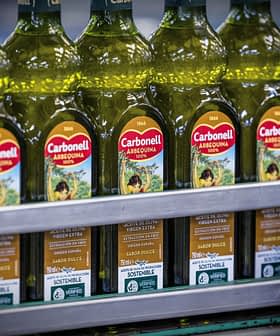Spain imported more olive oil than it made in October, the first month of the current season, a market report from Spain’s Olive Oil Agency shows.
A total of 6,200 tons of olive oil was produced, just one third of that for the same month last year but nearly equal to October 2010/11.
Meanwhile, Spain’s olive oil imports for October provisionally total 6500 tons, up from 2300 in October last year and 700 in 2011, and above the monthly averages of 4980 for 2011/12 and 3600 for 2010/11.
The figures come amid a forecast by major Spanish olive oil organization Infaoliva — based on expected output of just over 625,300 tons in 2012/13 — that Spain will fall about 200,000 tons short of its combined foreign and domestic demand this season, with consequent upward pressure on prices.
Yield down slightly
About 46,500 tons of olives were processed in October in Spain, where the harvest to date has been slowed by rain and is yet to get underway in all parts of the country. The average yield so far is 13.1 percent, 2.4 percentage points lower than last season, the AAO said.
Exports and domestic demand
Olive oil sales in October totaled 112,100 tons which while down six percent on last year was up 5 percent on the average for the last four years.
Provisional figures put the month’s exports at 75,000 tons, down 9 percent on 2011’s 82,800 tons and also down on 79,300 in 2010, but nevertheless up 8 percent on the average for the last four seasons.
Just over 37,000 tons were sold on the domestic market in October, a rise of 1 percent on last year and equal to the average for the last four seasons, but down from 40,400 tons in October 2010.
Olive oil stocks
Spain ended October with stocks of 591,600 tons, looming 95 percent above the average for the last four seasons and well above its 375,500 the same time last year.
About 415,400 tons are in olive mills; 176,200 in bottling, refining and other plants; and another 99,500 — of virgin and extra virgin — are off the market as part of European Union private storage market intervention.
Table olives
Just over 406,800 tons of table olives have been produced, down 16 percent on October last year.
Exports are up a fifth on last year, with 94,350 tons sold in October, 56,910 in exports and 37,440 in the domestic market. Table olive stocks at the end of October totaled 653,310 tons, down 15 percent on the same time last year.
Bulk prices down despite poor harvest prospects
Notwithstanding the reduced production, ex-mill olive oil prices went down again in the last week of November.
Spain’s olive oil price information system POOLred shows an average weighted price on November 30 of the equivalent of nearly €2.33/kg, down from nearly €2.41/kg in mid-November but still well up from €1.87per kg in late July, around the time prices started to rise after a long period at low levels.
According to the Olimerca online magazine, ex-mill virgin oils are currently available from the equivalent of about €2.25/kg. Better prices have been observed for new extra virgins, at about €2.46/kg, while no buyer would pay more than €2.34/kg for older extra virgin oils from Jaén. However, overall the the situation for the last 6 – 7 weeks has been marked by scarce sales to bottlers and refineries, it said.
Perplexity over market dynamics
Those involved in the olive oil market concur in not understanding what is happening within it at the moment, given the context of the much smaller harvest expected this season, the magazine said.
“Unless the pressure of the high level of stocks in the mills (415,000 tons) and the need for liquidity is forcing companies to sell whatever way they can to free up silo space for the arrival of new oils.”
Olimerca also noted that Italy, usually one of the main buyers of bulk oil from Spain, had in the last month bought very little, “because it is sourcing Greek oil at a better price.”








